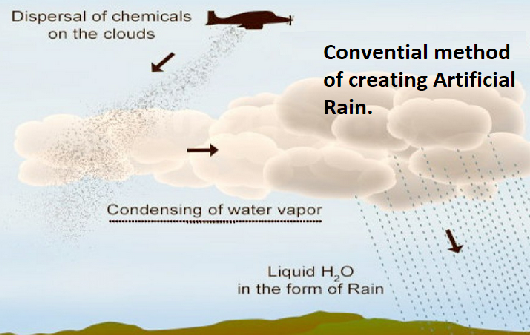ARTIFICIALLY STIMULATED PRECIPITATION IS OF THE OUTMOST IMPORTANCE.
The basis of precipitation is condensation of atmospheric water vapour as it is cooled down to the point of dew (i.e. to 100% relative humidity)
- The lower part of the atmosphere up on to a height of 1.5 km above the sea level contains approximately 50% of the total amount of all atmospheric water vapour.
- The water vapour content of a column of air above 1 m2 surface on sea level contains:
- on average 28.5 kg of water vapour.
- And varies between ~ 15 kg/m2 for deserts to ~ 53 kg/m2 above the ocean at equatorial latitudes.
A given volume of atmosphere can only contain a certain amount of water vapour (fmax) that is related to a predetermined temperature (the dew point)
The water vapour is always present in the atmosphere and represents an estimates 6 times the amount of all freshwater resources in the world. Due to the global warming the atmospherical vapour content increases.
Even a small rain-shower can produce thousands of tons of fresh water.
ARTIFICIAL UPDRAFT AND PRECIPITATION
Adjustable updrafts in the atmosphere and stimulation of precipitation.
The displayed preliminary apparatus and the proposed method is proposed for producing an controlled ascending air flow in the atmosphere. This ascending airflow has the capacity and capability to pierce through temperature inversion layers in an anticyclone.
By making uses of the energy of the burning flare gases process:
- Create artificially clouds and stimulate rainfall.
- The injection of condensations nuclei to initiate the coalescent process of forming rain droplets.
- Dispersion of air pollutants, aerosols, soot, dust especially in areas that air inflicted by several forms of air pollution such as:
- Industrial air pollution, soot,
- Burning of fossil fuels,
- Black carbon and organic carbon particles,
- Sulphate and nitrate compounds,
- Mining dust.
Collateral benefits
- The device can also be used for meteorological studies of atmospheric processes under controlled conditions.
- Generating energy using waste heat.
- Enhancing human health in air polluted livelihoods.
THE PROBLEM DEFINITION
In order to cause precipitation, it is necessary to:
- To artificially displace ground-level air to a required altitude (to the cloud-formation level).
- Together with essential condensation particles.
- To overcome atmospherical layers of temperature inversions and downward air displacement in anti cyclones.
- Trigger the process of cumulonimbus clouds formation by condensation of atmospheric vapour.
THE METHODS
Utilization of atmospheric heat
Making use of the Artificial Vortex Engine (AVE) in a more traditional manor would involve a greenhouse. As a result of the greenhouse effect under a transparent roof (solar collector) the heated air continuously flows from the roof perimeter into the chimney (updraft tower). A turbine is set in the path of the air current to convert the kinetic energy of the flowing air into electricity.
Utilization of waste gases from industrial processes
Making use of the Artificial Vortex Engine (AVE) by means of utilization of waste gases from industrial processes. Particularly suitable would be waste gases which are containing a high water content.
Injection of those high velocity gases into a vortex chamber would facilitate demonstration of the principle of the updraft vortex. At the same time eliminating the need for a relatively expensive heat exchange system.
Utilization of geothermic resources
Instead of industrial gasses one could make use of geothermic resources the AVE.
HOW MUCH PRECIPITATION CAN BE EXPECTED?
A 200 MWe vortex engine is expected to generate around 12 thousand tonnes of precipitation per day, assuming 1% atmospheric water content and evaporation losses of up to 50% in falling to earth. If the vortex engines were installed at 10 km centres, this would theoretically yield around
50 mm per annum. There is some reason to believe this may be amplified by natural processes.
 GROUNDWATER DEPLETION IS ACCELERATING
GROUNDWATER DEPLETION IS ACCELERATING
Groundwater is the largest reservoir of freshwater.
People depend on it for agriculture and their daily lives. Groundwater depletion has become a serious issue for many years, as it is used up faster than it can be recharged
Read more...
FRESHWATER STRICTLY LIMITED
 FRESH WATER JUST 2,5% OF ALL WATER
FRESH WATER JUST 2,5% OF ALL WATER
Abundant water exists on our planet,
97.5 % is salt water in the oceans.
freshwater just 2.5 %!
Read more...






 FRESH WATER OR HOW TO FEED 10 BILLION PEOPLE BY 2050 IN A WARMING WORLD?
FRESH WATER OR HOW TO FEED 10 BILLION PEOPLE BY 2050 IN A WARMING WORLD? EXTREME WEATHER EVENTS
EXTREME WEATHER EVENTS 
 WATER AND AGRICULTURE
WATER AND AGRICULTURE